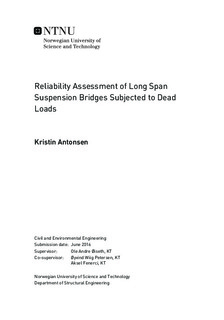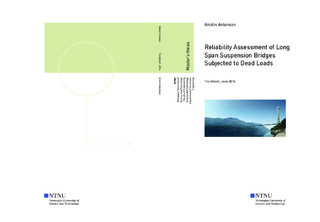| dc.description.abstract | In the present study the influence of standardized safety factors in large and heavy structures, where the major loading arises from self-weight of the structure itself, is considered. For this purpose, a reliability analysis of the Hardanger Bridge is performed. The loading is assumed to originate from the self-weight of the bridge deck, hangers and main cables only, i.e. all other loads are neglected.
The reliability analysis is performed by comparing axial loading and resistance capacity in the main cables and hangers. The loading is calibrated by interpolation between a simulated influence surface and estimated values of the self-weight and its location. Calibrations and estimations of the axial loading are performed by taking advantage of a data simulation tools and programs, such as MATLAB and ABAQUS. The resistance capacities are estimated from obtained test data performed by the manufacturer, along with tabulated values in codes and manuals.
Notice, simplifications and assumptions are made in this thesis in order to estimate input variables in the analysis and to be able to perform the analysis itself. It is assumed that uncertainties related to these simplifications and assumptions are negligible.
Use of ordinary numerical simulations for the reliability analysis is not possible due to low failure probability. Hence, an Enhanced Monte Carlo method (developed at NTNU) is applied. The method consists of parameterization of the limit state function M=R-S, thus true probability of failure is found by extrapolation of the obtained failure probability data from the parameterized limit state function. Results from the method give values for the reliability index β in the range of {12.5-14.6}, corresponding values for the probability of failure per year is equal to {〖1∙10〗^(-48)-〖5∙10〗^(-36)}. However, it is important to notice the inherent uncertainties in this results, due to the lack of available information in the extrapolation work, along with uncertainties related to the portion of subjective assumptions and simplifications. More simulations n should be performed in order to reduce the amount of uncertainties. Despite the uncertainties, the results show significant higher safety level than required in codes.
In order to strengthen the results, code calibration of partial safety factors corresponding to axial loading and resistance capacity are carried out. The calibration process is performed by using an iterative second-moment reliability method, along with a load and resistance factor design format (LRFD). The calibration process was performed by taking advantage of the useful data tools MATLAB and Excel. Results for the partial safety factors calibration are compared to standardized safety factors from codes. By inserting standardized safety factors, value for the reliability index β=12.64 is obtained. This gives a probability of failure equal to p_f=〖6.76∙10〗^(-37), which is in agreement with the result from Enhanced Monte Carlo method. | |

